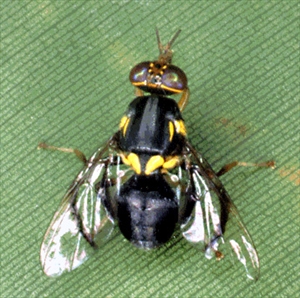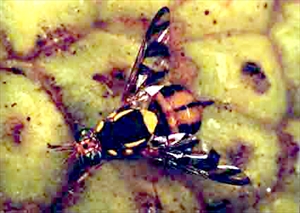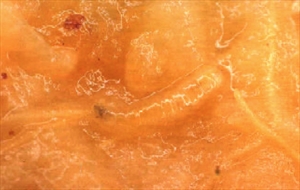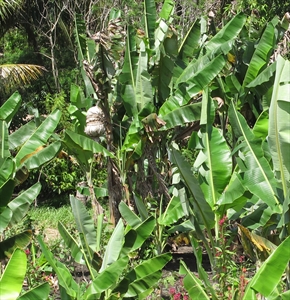Breadfruit fly, mango fly, melon fly, Solomon fly
Pacific Pests, Pathogens and Weeds - Online edition
Pacific Pests, Pathogens & Weeds
Solomon Islands fruit flies (021)
Mango fly (Bactrocera frauenfeldi) (Photo 1); melon fly [Zeugodacus (Bactrocera) cucurbitae)] (Photo 2); breadfruit fly (Bactrocera umbrosa) (Photo 3); Solomon fly (Dacus solomonensis ) (Photo 4). There are many more fruit fly species in Solomon Islands, but these are pests of economic importance.
The SPC Pacific Fruit Fly Project records 48 species in Solomon Islands (http://www.spc.int/lrd/country-profiles/solomon-islands).
The distribution of the four most important fruit flies in Solomon Islands, elsewhere in the Pacific island region:
Dacus solomonensis (Solomon fly): Bougainville, Papua New Guinea.
Bactrocera umbrosa (breadfruit fly): Southeast Asia, Australia (Christmas Island), New Caledonia, Palau, Papua New Guinea, Timor-Leste, and Vanuatu.
Zeugodacus (Bactrocera) cucurbitae (melon fly): Asia as far west as Pakistan, East Africa, Australia (Queensland, Christmas Island), Guam, Kiribati, Nauru, New Zealand, Northern Mariana Islands, Papua New Guinea, and Timor-Leste.
Bactrocera frauenfeldi (mango fly): Common in Papua New Guinea, and also in Australia, Federated States of Micronesia, Guam, Kiribati, Marshall Islands, Nauru, Northern Mariana Islands, and Palau.
The hosts of the species of economic importance are:
Bactrocera frauenfeldi infests: a wide range of hosts that are of importance to subsistence and commercial agriculture, including, avocado, black sapote, breadfruit, capsicum, carambola, cut nut, golden apple (wi in Fiji), grapefruit, guava, jackfruit, kumquat, mango, Malay apple, papaya, paper mulberry, passion fruit, plantain, pomelo, sapodilla, snake gourd, sour orange, soursop, Tahitian chestnut (Inocarpus fagifer), and Indian or tropical almond (Terminalia catappa). Wild hosts are Indian laurel (Calophyllum inophyllum), figs, and many forest fruits.
Bactrocera umbrosa infests: breadfruit and jackfruit.
Dacus solomonensis infests: cucumber, pumpkin and particularly snake gourd.
Zeugodacus (Bactrocera) cucurbitae infests: cucurbits, including watermelon, cucumber, pumpkin, snake gourd, bitter gourd and ivy gourd.
Bactrocera frauenfeldi is mostly black, about 6 mm long, with a dark stripe across the wings (Photo 1).
Zeugodacus (Bactrocera) cucurbitae is orange-brown, about 8 mm long, with three yellow stripes along their backs, and two brown spots near the wing tips (Photo 2).
Bactrocera umbrosa are about 8 mm long, with bold black, yellow and orange body markings, and three wide brown bands on the wings (Photo 3).
Dacus solomonensis look like a wasp with a slim waist; it has a brown body about 12 mm long, and wings with a brown band along the front edge (Photo 4).
Female flies lay eggs in fruit, leaving small holes in the skin. Eggs are white or pale yellow, about 0.8 mm long and 0.2 mm wide (Photo 5). As the female lays eggs, it also adds bacteria from the fruit surface; these help rot the fruit and provide food for the larvae or maggots.
The eggs hatch after 1 or 2 days, with the maggots feeding on rotting fruit flesh (Photo 6). Maggots are white, and their body tapers to a pointed head containing a pair of black mouth-hooks. The maggots grow to different sizes: mango fly up to 8 mm, melon and breadfruit fly up to 11 mm, and Solomon fly even larger. There are three moults. After 1-2 weeks, the maggots are fully grown and they drop to the ground and burrow into the soil. Their skins harden to form brown, barrel-shaped pupae (Photo 7). These hatch into adult flies after 1 or 2 weeks.
The fruit flies feed on the juices from fruit, nectar from flowers, honeydew from insects, bird faeces and bacteria. Young females need protein foods before they become sexually mature and able to lay viable eggs. Fruit flies find the fruits to lay in by their colour, shape and the smell of the fruit, leaves and the bacteria on them.
The flies mate and lay eggs about 2 weeks after pupation. Melon and breadfruit flies mate at dusk, while mango fly mates at any time. Female flies need protein to develop eggs. Melon fly females lay more than 1000 eggs, and live for about 5 months, longer than the other species.
Eggs are laid in fruit, and maggots cause the fruits to rot. Melon fly may also lay eggs in flower buds and stems. It is an important fruit fly, destroying crops of pumpkin and snake gourd. The SPC Pacific Fruit Fly Project records the following about these four species:
Solomon fly: This species and the melon fly are responsible for over 90% of the damage to snake gourd, and 60-85% damage on pumpkin.
Mango fly: About 30% of guava are damaged.
Breadfruit fly: 30% of fruits in Vanuatu and 75% in Papua New Guinea (with Bactrocera frauenfeldi)
Melon fly: In Papua New Guinea, 95% of bitter gourd fruits are infested and destroyed. In Solomon Islands, it attacks over 90% of snake gourds (with Solomon fly) and 60-85% of pumpkins.
Look for rotten fruit, and small holes in the skin. Open up fruits and look for maggots inside. Rear maggots to determine species. Distinctive features are: Melon fly: yellow stripe in the middle of the upper body between the wings, a black T on the rear body; and dark patches on edge of wings. Mango fly: reddish-brown with yellowish abdominal cross bands, transparent wings with small brown spots on the tips. Breadfruit fly: mix of black with yellow stripes, and wings with broad black bands. Solomon fly: large, reddish-brown. Lures are used: either Cue-lure, to attracts mango, melon and Solomon fly, or methyl eugenol, to attract breadfruit fly.
QUARANTINE
Melon fly, which entered Solomon Islands from Papua New Guinea in 1984, is not present yet in Makira, Rennell/Bellona and Temotu Provinces, and neither is it present in Fiji, Samoa or Tonga.
NATURAL ENEMIES
Fruit fly maggots are parasitised by small wasps. Spiders, ants, assassin bugs, and beetles feed on maggots, pupae and adults. Weaver ants (Oecophylla) stop flies from laying eggs. Chickens, pigs and flying foxes eat the fruit and maggots. In general, predators (spiders, ants, assassin bugs and carabid beetles) have had little effect on populations of fruit flies. Parasitoids, too, have only been found at low levels in Pacific island countries, and introducing others is probably not worthwhile.
BIOLOGICAL CONTROL
The braconid wasp, Opius fletcheri, was introduced to Hawaii in 1910, and considered to have been beneficial, reducing the population of melon fly by about 25%. It is present in Guam.
CULTURAL CONTROL
An integrated approach to fruit fly management is needed which combines bagging of fruit, fruit production during times of low fruit fly populations, the use of less susceptible varieties, hygiene measures, and protein bait sprays.
Before planting:
- Choose varieties of fruits and vegetables that are less susceptible to attack and, if possible, harvest early to avoid infestation.
- Consider growing crops in the cooler months when fruit fly populations are at their lowest. For instance, during the cooler months of May to August the damage caused to capsicums in, e.g., Tonga falls to about 10%.
During growth:
- Collect fallen, damaged and overripe fruits, and bury them (at least 50 cm), feed them to pigs or seal them inside plastic bags and put in direct sunlight for several hours. Control by sanitation is best if all growers do it routinely over as wide an area as possible.
- Bag the fruit with double layers of newspaper or use brown paper bags. On three sides, fold over the edge of the newspaper for 2 cm, and staple the folds in place (Photos 7). Place the fruit in the bags as shown. This is a suitable method for protecting starfruit (Averrhoa carambola), mangoes and also snake gourd (Trichosanthes cucumerina).
- Alternatively, instead of newspaper, use leaves of Pandanus, betel nut, sago palm or swamp taro, after softening over a fire to wrap the fruit. In Papua New Guinea, whole banana bunches are bagged inside banana leaves to stop banana fly and to improve market look (Photo 9).
- Encourage weaver ants (Oecophylla), by placing bamboo poles as 'roads' from nests to new areas. Useful in citrus, native almond and mango.
- Harvest early before the fruit is susceptible to fruit fly attack. This method is used for bananas and papaya. Bananas are harvested green and papaya at colour break.
After harvest:
- Collect all discarded fruit and destroy them using the methods listed above.
RESISTANT VARIETIES
Some fruit varieties have been tested and found to be 'non-hosts' for fruit flies, for instance, the chilli varieties 'Hot Rod' and 'Red Fire' in Fiji. Also, pineapples are non-hosts for fruit flies in Fiji at any stage. Other crops that may be non-hosts or low risk are squash, pumpkin, zucchini, cucumber, and some varieties of watermelon, rock melon, limes and papaya at colour break. Check with the agriculture authorities for the latest tests that have been done, and lists of appropriate varieties.
CHEMICAL CONTROL
Female fruit flies need protein for their eggs to mature properly. Protein bait sprays make use of this need by combining a protein source with an insecticide. In Pacific island countries, the protein is either a commercial autolysed yeast product (MPPIL, Mauri's Pinnacle Protein Insect Lure) - broken up yeast cells in which the proteins have been converted into simpler compounds using enzymes - or protein autolysate from brewery yeast waste. In Tonga, the product is known as Royal Tongalure. Bait sprays are also available in Papua New Guinea (mango fly on guava and carambola) and Vanuatu.
If MPPIL is used, place 50 ml MPPIL concentrate and 4 ml malathion 50% emulsifiable concentrate into a bottle and make it up to 1 litre with water. If Royal Tongalure is used, replace the MPPL with 100 ml of Royal Tongalure in the MPPIL recipe above.
The bait solutions are sprayed at a rate of 50 ml per m2 on each tree in the orchard, and on surrounding trees. On capsicum, chillies and cucurbits, 20-25 litres per hectare are applied as a spray to every third row.
A third product called Bactrogel has been developed; this is a powder containing fipronil. Add 50 g Bactrogel to 9.7 litres water, stir to dissolve, and add 300 ml protein bait concentrate, and again stir to dissolve. Much smaller amounts are needed compared to the other two. Apply 10 ml to lower surface of leaves on each tree. For vegetables, spray 5-10 ml at 4 m intervals along rows, and every 2-3 rows, depending on spacing. Small, hand-held sprayers can be used which deliver a coarse straight jet of liquid.
____________________
When using a pesticide, always wear protective clothing and follow the instructions on the product label, such as dosage, timing of application, and pre-harvest interval. Recommendations will vary with the crop and system of cultivation. Expert advice on the most appropriate pesticide to use should always be sought from local agricultural authorities.
AUTHORS Helen Tsatsia & Grahame Jackson
Information (and photos 1,3-9) Leblanc L (2000) Fruit flies in Solomon Islands, SPC Pest Advisory Leaflet 30 (https://lrd.spc.int/pest-advisory-leaflet?start=10); and from Allwood A et al. (Fruit fly control methods for Pacific island countries and territories (2001), SPC Pest Advisory Leaflet 40. SPC, Noumea, New Caledonia. (https://lrd.spc.int/pubs/cat_view/469-pest-advisory-leaflets). Photo 2 Scott Bauer, USDA Agricultural Research Service, Bugwood.org.
Produced with support from the Australian Centre for International Agricultural Research under project PC/2010/090: Strengthening integrated crop management research in the Pacific Islands in support of sustainable intensification of high-value crop production, implemented by the University of Queensland and the Secretariat of the Pacific Community.












